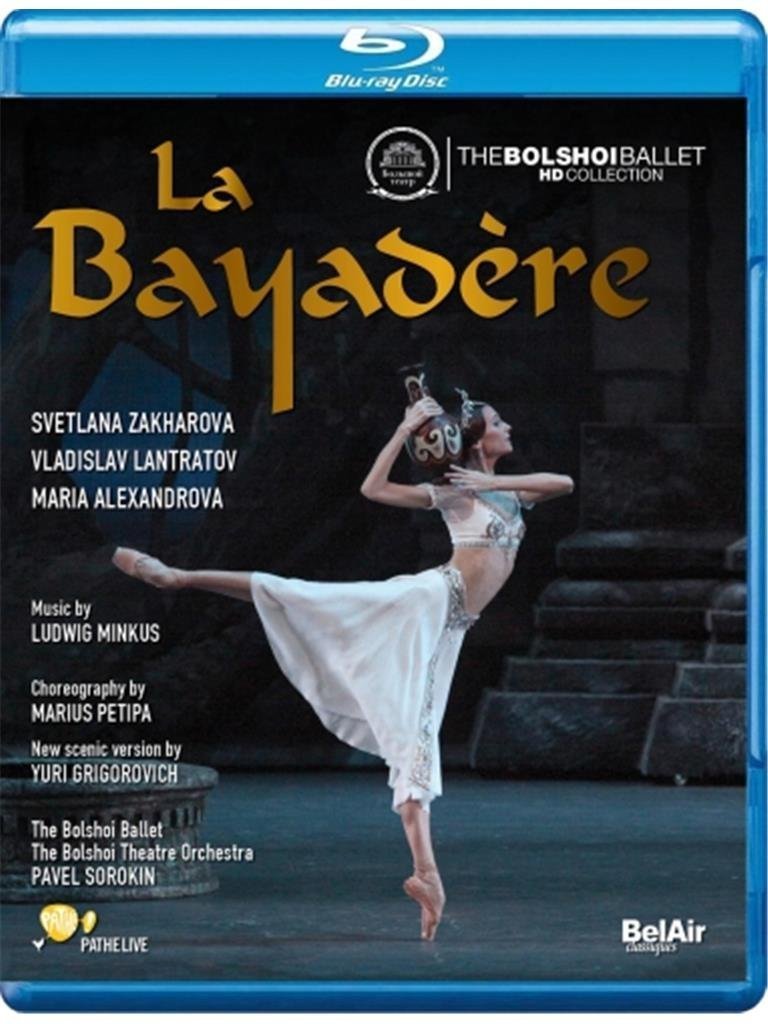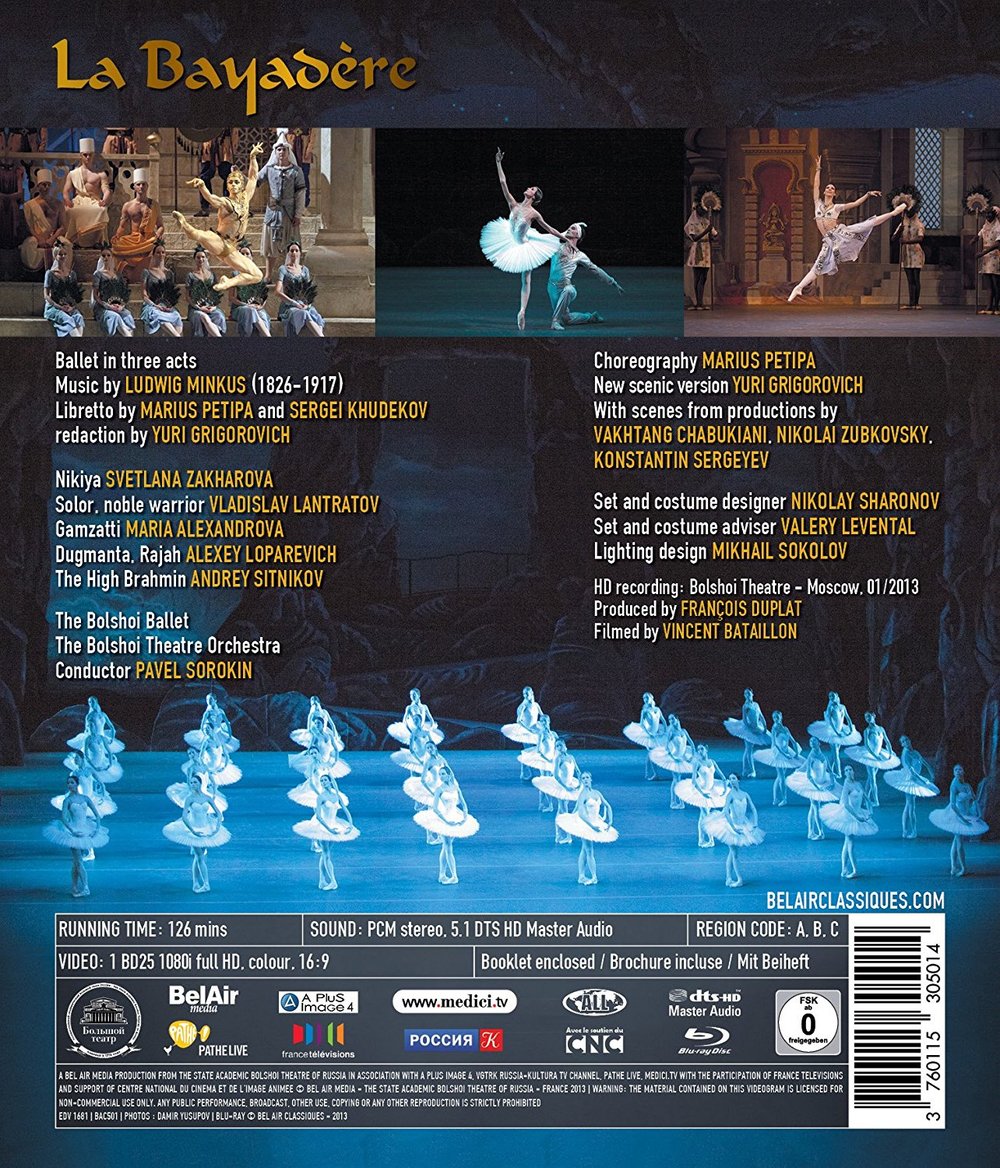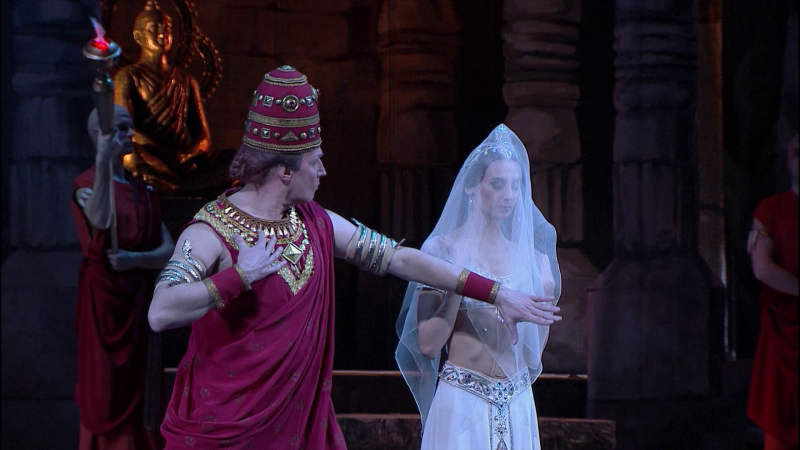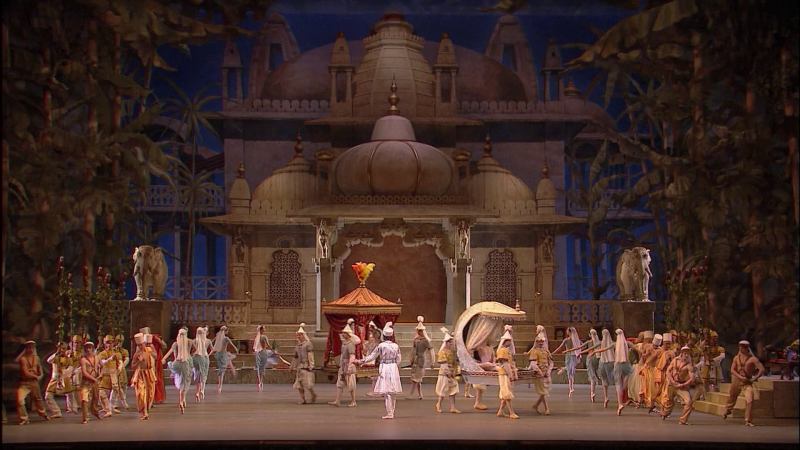

💓 La Bayadère ("The Temple Dancer") ballet. Music by Ludwig Minkus. Libretto by Marius Petipa and Sergei Khudekov redacted by Yuri Grigorovich. Choreographed by Marius Petipa with new scenic version by Yuri Grigorovich and also with scenes from productions by Vakhtang Chabukiani, Nikolai Zubkovsky, and Konstantin Sergeyev. Recorded January 2013 at the Bolshoi. Stars Svetlana Zakharova (Nikiya, the Bayadère), Vladislav Lantratov (Solor), Maria Alexandrova (Gamzatti), Alexey Loparevich (Rajah Dugmanta), Andrey Sitnikov (High Brahmin), Denis Medvedev (The Golden Idol), Alexander Voytyuk (Warrior Toloragva), Denis Rodkin (a Slave), Anton Savichev (Magadaveya, a fakir) Anastasia Vinokur (Aya, a Slave), Yulia Lunkina, Svetlana Pavlova (Gumpe), Karim Abdulin, Ivan Alexeyev, Anna Leonova, Yanina Parienko, Anna Okuneva, Maria Vinogradova, Svetlana Pavlova, Yulia Lunkina, Anastasya Gubanova, Elizaveta Kruteleva (Grand Pas), Anna Antropova, Vitaly Biktimirov, Igor Tsvirko (Drum dance), Anna Rebetskaya, Polina Dyachkova, Irina Chuvakina (Manu dance), Anastasia Stashkevich (First Shade), Anna Tikhomirova (Second Shade), and Chinara Alizade (Third Shade). Pavel Sorokin conducts the Bolshoi Theater Orchestra. Set and costume designs by Nikolay Sharonov with advice from Valery Levental; lighting by Mikhail Sokolov. Directed for TV by Vincent Bataillon; produced by François Duplat. Released 2013, disc has 5.1 dts-HD Master Audio sound. Grade: A+
Let's take a moment to consider the astonishing career of choreographer Yuri Grigorovich. He was born about the time Stalin began the great collectivization of soviet agriculture. As as school boy, Grigorovich witnessed the Great Terror. He was lucky enough to be too young to fight in World War II.
He graduated from grade school in 1946 and went into dancing. He worked his way up as dancer and choreographer until he joined the Bolshoi in Moscow in 1964. Stalin was then long dead, but Communist orthodoxy still ruled for almost three more decades. In 1967, Grigorovich presented Spartacus, a semi-propaganda ballet that was the "calling card" for the Bolshoi for many years. Grigorovich survived the Communist era. But in 1995 he was, I think, more or less forced to retire by forces that considered him too reactionary to stay at the Bolshoi.
Grigorovich was then 68, but he never stopped working. He found many other appointments as choreographer and administrator. In 2008, at the age of 81, he was called back to be general choreographer of the Bolshoi! At this time the Bolshoi was in the final years of a long and hugely expensive renovation of the Bolshoi Theater. From our perspective, Grigorovich's next great achievement was his magisterial Sleeping Beauty production which was the first ballet shown at the renovated Bolshoi building. The Sleeping Beauty came out in HDVD in 2012. In 2013, Grigorovich had another hit HDVD with subject title La Bayadère.
It's now late 2016 and Grigorovich (about 90) is alive and still listed on the Bolshoi website as its main choreographer. But in 2015, the Bolshoi released a Grigorovich Swan Lake HDVD that was a big flop, so it appears Yuri's career is now effectively over.
Here, from the Grigorovich La Bayadère, are a couple of shots of the recently renovated Bolshoi Theater:
The pit is deep so there can be considerable light without bothering the spectators:
Now on to La Bayadère. Act 1 opens with a mysterious temple set in the midst of giant jungle trees. The set is impressive on a TV display, but it's too dark to allow a good screenshot. Here we see The High Brahmin (Andrey Sitnikov) with temple girls outside the temple:
The High Brahmin meets the new Bayadère (Svetlana Zakharova) and is astonished at her beauty:
The Bayadère's name is Nikiya. Although he has taken a vow of celibacy, The High Brahmin declares love:
Nikiya firmly rejects the advances of The High Brahmin:
Nikiya is in love with Solor (Vladislav Lantratov), a noble warrior and hunter. Before the sacred fire, Solor pledges eternal fidelity to Nikiya:
Scene 2 of Act 1 opens in the palace of the Rajah. The Rajah (Alexey Loparevich) is on the left dressed in white. The girl in the center is Gamzatti, the Rajah's daughter.
The Rajah plans for his daughter to marry Solor. The High Brahmin explains that Solor is pledged to the Bayadère, who is a commoner. The High Brahmin hoped in this way to get rid of Solor, who would be banished. But his plan backfires when the Rajah, clenching his fist, calls for Nikiya's death!
In this production, Gamzatti is not a bad girl—she just loves Solor too. She has a more practical idea: she will bribe Nikiya to renounce Solor, and all will be well:
When Nikiya understands what is happening, she goes after Gamzatti with a knife. This seals her doom. Now the Rajah has a security reason for eliminating this Bayadère. And the Rajah will come up with a spectacularly exotic way to kill Nikiya:
In Act 2, we see yet another magnificent set, an outdoor pavilion for festivities. The Rajah supervises the arrangements for a feast to celebrate the engagement of Gamzatti and Solor. Each of them arrives in sedan chairs:
After the grand procession, there are 6 dance scenes in honor of the engaged couple. The next 3 shots come from these 6 dances. First is a close-up of the "Dance with Fans":
The famous "Dance of the Golden Idol":
The "Manu (jug) Dance" with 2 adorable star students from the Bolshoi school:
Next comes a grand pas d'action with Gamzatti and Solor:
By custom, the ceremony should end with a dance by the Bayadère. Nikiya has to dance, and everyone can see her anguish:
Nikiya's humiliation is complete:
The Rajah has arranged for a servant to give Nikiya flowers. The servant sends the flowers via a fakir whom Nikiya trusts. Only the Rajah and the servant know a poisonous snake is hidden in the flowers. Racked with grief, Nikiya sees the flowers and shocks the audience with a manic dance of almost silly happiness. Cuddling the flowers, Nikiya is an easy target for the snake, who bites her on the neck:
The High Brahmin gives Nikiya an antidote for the snakebite, but Nikiya discards the vial and chooses to die. Gamzatti, realizing what her father has done, runs away in horror. And it starts to dawn on Solor what a louse he has been:
In Act 3, Grigorovich has come up with what may be the most impressive Bayadère dream scene in recent times (or of all history perhaps). I'm talking now, of course, about the famous scene of the shades of dead, mistreated girls trooping down ramps to the dance floor. The Royal Opera House in its current Bayadère video uses one ramps and 24 shades. Grigorovich marshals 32 girls moving down 4 ramps. In my home theater the shades are bathed in pure white light that truly makes them look like ghosts. You might think on first glance that the film was shot in black and white. I think this gray-white presentation of the shades is what the audience in the Bolshoi Theater saw. On my computer monitor, the girls and their dresses have a bluish tint; and I think that is a local artifact. In the next screenshot, you see 10 shades on the top three ramps on their way down to the stage floor:
In this shot, 16 shades fill up the four ramps:
Heavy traffic in close-up:
Now all 32 shades are on the way down (the top ramp is now cleared):
The outcome of the grand descent; isn't this all just astonishingly beautiful?
The shade of Nikiya and Solor in pas de deux:
The First Shade Variation danced by Anastasia Stashkevich:
The Second Shade Variation danced by Anna Tikhomirova:
The Third Shade Variation danced by Chinara Alizade:
The Bayadère and her last good-bye to Solor:
Below is the only trick shot in the video: I hope you can see the double image of Solor lying on the floor in the foreground and in the middle of the vast stage in the background:
The screenshots show you the enormity of the Bolshoi stage. Vincent Bataillon provides many full stage shots for those conservative ballet fans who like to see the whole picture. But at full range, the dancers are so small! So Bataillon often moves in closer. I did a Ballet Wonk Worksheet for this recording. The whole video is just as strong as the production itself with a stately pace of 17.5 seconds per clip. 82% of the clips show the whole bodies of the dancers. And Bataillon also provides a good selection of near shots (waist/torso) and well as about 5 extreme close-ups. I would site Bataillon's work here as an ideal example of proper video content for a ballet with a variety of views to please everyone while always maintaining the utmost in good taste. His serene camera work perfectly matches the overall majesty of the Gregorovich conception. Finally, I note the audience gave the dancers a lot of spontaneous applause and there were bows throughout. All this is faithfully recorded in the video, which makes for a more exciting experience in the HT.
Again I note that this looks much better in the HT than in these screenshots. I can't think of a single critical thing to say about this wonderful production, and I give it an A+ grade as a definitive recording of this famous ballet. This Bolshoi recording sets the standard against which all other recordings of La Bayadère will be judged. So I'm giving this recording the 💓 designation (the third for Bataillon!).
OR






































